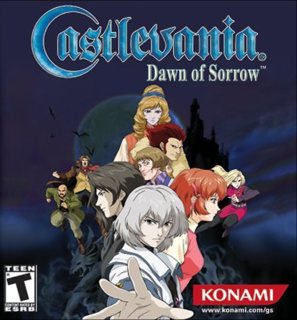Dawn of Sorrow is a decent 2-D side-scroller that mixes together a variation of role-playing elements and the horror/adv
You might be thinking that, with the 2-D format, there would be some totally trippin’ touch screen facets. On the contrary, all you’re dealt with is a few scrolls to open doors via the stylus throughout the game. That means you get to use the buttons that are so heavily neglected nowadays with the DS. While you can personalize the button commands to your liking, the game’s controls are very similar to an average DS game. You can jump, wield some sort of small weapon, wield some sort of large weapon—which will drain your stamina every time you use it—and you can slide into enemies or down to lower floors.
Most of the weapons are quite ingenious and well conceived. As you delve further into the game, the number of choice weapons proliferates, and most of them are there just for the looks. You can easily slash through the majority of the game with the same weapons you’ve acquired in the beginning. Still, if you want to be creative and have some fun with the game, having the most massive and destructive weapon at your disposal is very satisfying and, to an extent, comforting.
Occasionally, you’ll acquire abilities from the enemies you hack up, and most of them are pretty interesting. Speaking of which, the monsters you cross paths with are distorted, ruthless, and extremely fun to annihilate. Some are hideous reincarnations of animals or humans, while others are just enormously daunting. No matter the case, all of them have a creepy air about them, whether they spout fire or throw bones like boomerangs. The boss fights are what really stands out in Dawn of Sorrow. The bosses range from giant demons with fists bigger than you, to flying spirits with electric charges, and you can bet your bottom dollar that all of these fights are impressively displayed.
However, once you kill a monster, they’ll antagonistically respawn after you’ve left the vicinity. The vicinity could be anywhere from the next room to the next floor. And most of the rooms, later levels in general, are a tangled mess of intricateness. There are very few save rooms, and sometimes you just wish you could save whenever and wherever instead of having to lose your way and die a horrific death. The map can be a life-saver in difficult times, but the majorities of later levels are still very enormous and have too many rooms to consider. Occasionally it just feels like Konami propagated a bunch of rooms all throughout a particular level without having any original plans, and if they did, those plans didn’t turn out so well.
Most of the visual work is done with an anime notion. A lot of the characters look as if they came from a lost episode of Inuyasha, while others have distinctly made their prescience felt from past entries to the series, namely Aria of Sorrow. In general, the 2-D format looks great, and really brings out the best of the visuals, as well as sharpening the abilities and combat. But, for the most part, it’s nothing that we haven’t already seen, neither on the DS nor the GBA.
While the sound is vibrant and rich, there’s no voice acting, and it can really get monotonous while reading the subtitles (since some dialogue sequences can take up to five minutes or more). On top of that, a lot of the actions taken sound like Power Ranger commands, un-captivating swoosh repetitions and all. But the music sounds great and the monster deaths are pretty awesome. Once reaching a climatic scene, the music changes into a serious tone. Sometimes things will get very quiet, usually when you near a boss fight, which hypes your premature battle vigorously.
Since Dawn of Sorrow is a relatively long game, you’re not going to get a lot of replay value. Most of the extra modes become boring and there are just certain points in the game where it feels impossible to move on. Conversely, any RPG gamer will definitely enjoy Dawn of Sorrow. It’s a game that can get addicting if you’re making a strong run towards the final battle of a level, but it’s also difficult to play if you’re not gaining progress. Either way you look at it, it’s a challenging game that any DS owner should check out.
Over all, you’re not getting a lot with Dawn of Sorrow, but the boss battles, enemy hacking, and abilities are loads of fun all together. However, the story and level play stunt Dawn of Sorrow’s potential from becoming an overall great game. When it’s all said and done, though, enjoyment can precede you in this Dual Screen version of Castlevania.
-Tish-

